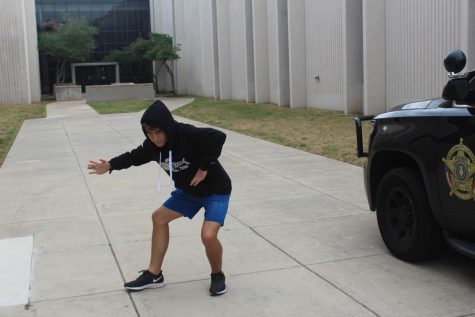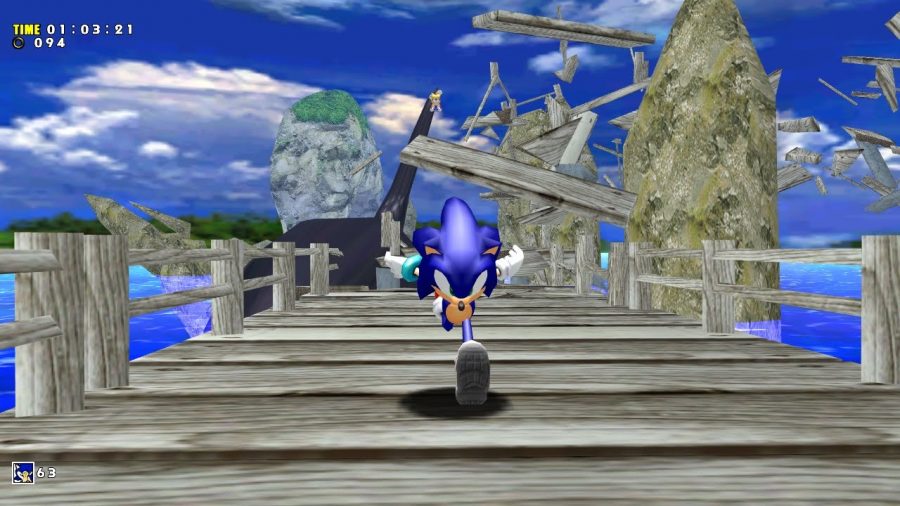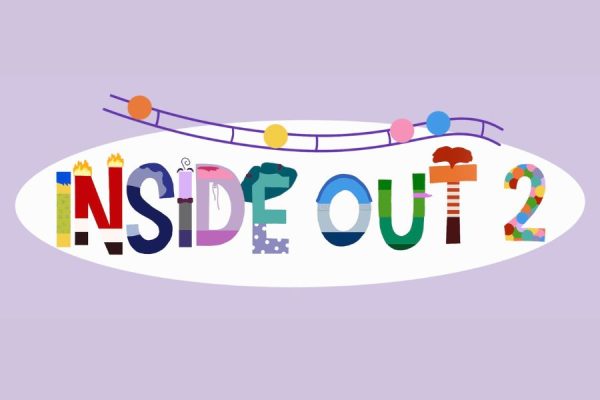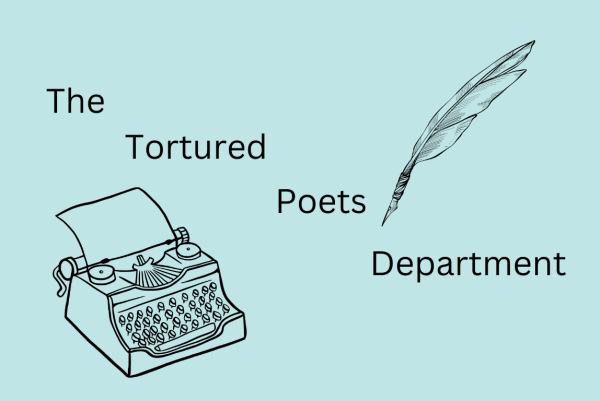‘Sonic Adventure’ Presents a Jumbled and Incoherent Game Experience
While Mario entered the 3D game scene in 1996, Sonic fans would have to wait a few more years for their first experience in 3D. Debuting on Dec. 23 on the Sega Dreamcast, Sonic Adventure was the first mainline Sonic game since Sonic 3 and Knuckles. However, quite unlike Super Mario 64, which has aged remarkably well for an early 3D game, Sonic Adventure definitely shows how much of a byproduct of the times it truly is.
Sonic Adventure has an extremely creative set-up for its levels, contrary to literally every other game in the Sonic series. For instance, in Sonic Adventure you play as different characters, all with their own stories. There are six, to be exact: Sonic, Tails, Knuckles, Amy, Big, and E-102 Gamma. All of the stories play with new controls, differing levels, and wildly fluctuating levels of quality. Consistency is definitely not the name of this game.
Sonic is by far the best character to play as in Sonic Adventure. While retaining the same basic style from his earlier genesis games, which revolved around going fast, exploring levels for rings and power ups, and platforming to reach tougher areas, the levels are now in a 3D landscape. This wildly changed the priorities, as the levels had to become a lot less complex due to hardware restrictions. A new attack was added to Sonic, the Homing Attack, which functions as both a double jump and a homing dash towards nearby enemies. This is most often used to chain together hits in the air, which can be very fun, and continues the platforming focus. Sonic goes through the most levels in the game, with a fairly well-designed difficulty curve, and it’s where the game truly shines. Even though there are a lot of bugs and glitches in this game, the gameplay overpowers them, and it’s very fun to revisit these stages.
Tails is very similar to Sonic, but he might be the least complete character in the game. Instead of having the Homing Attack, Tails can just straight-up fly, which makes sense given his design, but it also completely breaks the game, since he goes through just a few of the levels that were originally designed for Sonic. Instead of the goal being to reach the end of the stage as fast as possible, Tails races Sonic to the end, as his main character motivation is to break free of Sonic’s shadow, and prove himself worthy. However, since Tails can fly, and Sonic can’t, this becomes one of the easiest games ever made. Most levels are separated by sections with pitfalls, speeding through loops and turns, or platforming sections, all of which are completely bypassed by Tails’ flying ability. While this can be fun at first, as you completely destroy Sonic regardless of playing skill, it gets boring winning easily real quick, with the only somewhat difficult level being a snowboard stage where Tails cannot fly.
Knuckles’ campaign is a lot more complete, but it still is fairly uneventful. While Tails’ story reused complete levels from Sonic’s story, Knuckles is confined to a smaller section that was originally meant for Sonic to go through in mere minutes. His main goal is to search for missing shards of an emerald, and as such, these stages are called “Treasure hunting stages”. To assist in this, he has the ability to dig underground, and he can climb up walls with his spiked claws. He can also glide long distances if he gains height, which is a lot more balanced, compared to straight-up flight. Knuckles’ stages use a treasure radar, which starts beeping whenever you get close to one of the emerald shards. Since the stages are so small, and the radar is so easy to use, as it beeps for all the shards at once, this means that these levels are similarly easy, and they are nowhere near the quality and difficulty of the Sonic stages.
Amy is the last of the classic platforming characters, and she is also the weakest. You might think this would mean that her levels are the hardest, but they are yet again very easy. Her moveset is small, and hard to use; she has one move, which is to swing a hammer to damage enemies. If she’s moving at top speed, you can swing the hammer to boost you up, almost like a super jump, which is nice, because her regular jump is terrible. This isn’t the best option, because she also moves very slowly, which not only makes it very hard to ascend slopes and use her super jump, but also is a very obtuse design choice, coming from the game directors of Sonic the Hedgehog, the series known for being fast. Amy’s objective is similar to Tails’, but is different in the fact that instead of winning a race, she’s trying to get to the end of her stages before she gets caught by a robot who is chasing her. You might think that her nerfed controls might make her stages super hard, but not only is the robot’s AI terrible , along with him not showing up too often, you can also smack him with the hammer whenever you want, which knocks him down onto the ground. This makes her stages more annoying than fun, as you just have to disable the robot for a few seconds, then run slowly to the end. What makes this even worse is that her stages have random puzzles in them, just to slow you down, so the robot can catch up to you. The puzzles are so basic they amount to ‘match the colors’ or ‘flip the switch’ most of the time, and they don’t mix well with the already slow controls and slow challenge. All of this works against her campaign, and I don’t particularly enjoy it.
E-102 Gamma, while having a very short story, is one of the better playing characters in the game. His controls revolve around aiming a cannon and firing at other robots, and his levels, instead of timing you, countdown to zero. If you lock onto multiple targets and fire, you get extra time added to your timer, which gives you more leeway to finish. Unfortunately, like most other characters, his quick movement and enormous time bonuses given by the game make his campaign also quite short and easy. However, the story is by far the most moving; it’s more self contained than the others, but the ending is spectacular, and his goal to save all of his robot brethren from enslavement under the evil Dr. Eggman makes him one of my favorite video game characters, even if he was short-lived.
Big the Cat defies explanation. No words can describe how poor he is, in literally every way. While every other character has a coherent plot, passable controls, and have at least some fun moments and levels, Big the Cat is one of humanity’s greatest mistakes. His story literally just follows him trying to find a frog. You fish in bodies of water in levels. That’s literally it. The fishing controls are bad, the camera underwater sucks (which is especially odd considering that there was a critically acclaimed fishing game on the same console), and he’s so slow that it’s a pain just to get to other levels. Suffice it to say, there is no good reason to play as him, other than to complete the game, and whenever I have to play as him, I audibly groan, as I prepare my body for the worst hour of my entire life. He is seriously that bad.
In Sonic Adventure, you go through three different Adventure Fields, which are basically large overworlds with entrances to levels, minigames, and boss fights. While this was an interesting concept overall, and it does add to that feel of going through a cool new land, I do have some mixed feelings about this, especially since it doesn’t add too much to the game. The sequel Sonic Adventure 2 ditched these, and it left no gaping holes behind, so I prefer to think of the Adventure Fields as icing on the cake, if you will. Unfortunately, they also introduce some major issues as there are often lengthy time sinks between levels, where you have to carry some key item over to open an entrance, or go pick up an upgrade.
Every character has their own upgrades, with certain ones being necessary (i.e. Knuckles’ digging claws) or unnecessary (i.e. useless yet cool sunglasses), and they all add moves to the characters moveset, or power up their existing weapons. This system of upgrades isn’t just new to this game, but the entire series; unfortunately, it’s an interesting new idea that falls flat on its heels. So many upgrades are either basic movement options that should have already been in the character’s repertoire of moves, or are so incredibly useless that one could play through the entire game and not notice a single difference from a gameplay perspective. However, while some upgrades are required, some are hidden, around the Adventure Fields or in levels, and at the very least, it is satisfying to get something out of exploring these fields.
Sonic Adventure is a hard game to rank in my mind; there are some really fun levels, concepts, and the music is absolutely top-notch. However, this doesn’t excuse the fact that the vast majority of the game’s content is a bloated mess, with enjoyability being an overall mixed bag. The worst part is that you could definitely tell that if they had focused on fewer characters, toned down the Adventure Fields, and put their budget towards their better, more interesting content, the game would be a lot more enjoyable. It’s fun, but not very consistent overall.

Class of 2023
I like to eat, sleep, inhale oxygen, and occasionally run and swim. I used to live in Shanghai, I own 9 pets, and I play a metric ton...







talaiyah • Dec 6, 2023 at 7:34 am
why are there no real games